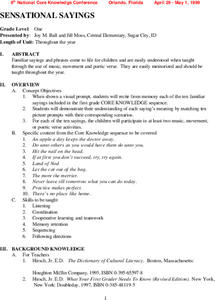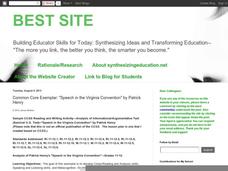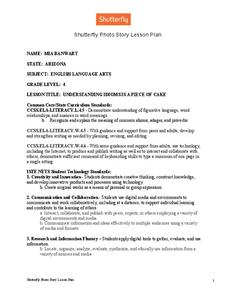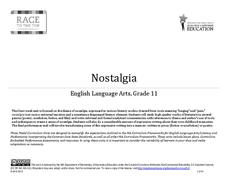Curated OER
Sensational Sayings
Students recognize and interpret the meaning of proverbs and saying through music, poetry and movement. In this familiar sayings lesson, students participate in various games and activities to gain understanding of the meanings of...
Curated OER
What Are Our Common Values?
Students make a poster. In this values instructional activity, students read the Preamble to the Constitution and discuss the core democratic values that are found there and in the Declaration of Independence. Students are each...
Curated OER
Speech in the Virginia Convention
“. . .different men often see the same subject in different lights. . .” but the great orator Patrick Henry used all the skills at his command to craft a speech to convince listeners to see things as he did--that liberty was worth dying...
Walters Art Museum
The Symbolism of Allegorical Art
Introduce learners to allegorical art with four bronze sculptures by Francesco Bertos. After modeling how to recognize bias and allegory in Bertos' Africa, class groups examine the other three sculptures in the series before creating...
Georgia Department of Education
Exploring Poetry and Poets
Combine the study of poetry and non-fiction texts with this complete and ready-to-use six-week unit. After reading numerous poems from local writers and compiling a personal anthology, high schoolers find and read a memoir or biography...
Curated OER
Poems: calligrams
Have fun with shape poems! First and second graders write calligrams that add to the meaning of their poems. Great for your poetry unit or if you want to combine poetry and art lessons.
Shutterfly
Photo Story Lesson Plan
After reading Loree Leedy's There's a Frog in My Throat: 440 Animal Sayings a Little Bird Told Me, kids create and illustrate their own poems that convey the meaning of an idiom. The poems are then transferred into Shutterfly's Photo...
Reed Novel Studies
No Talking: Novel Study
Many of the world's most inspirational sayings are attributed to Mahatma Gandhi. Using the No Talking novel study, pupils research and write about one of his sayings. Additionally, they practice alliteration and write a quintet that...
Reed Novel Studies
Hello Universe: Novel Study
Every neighborhood has its own unique cast of characters, and the crew in the novel Hello Universe is no exception. The characters in Erin Entrada Kelly's novel take center stage in a study guide based on the text. Readers answer...
Reed Novel Studies
James and the Giant Peach: Novel Study
Everyone wants to feel like they belong. James, in James and the Giant Peach, finds a feeling of belonging in a very odd place—inside a peach! Scholars read the story of James and the Peach and work through vocabulary, language, and...
Reed Novel Studies
The Great Gatsby: Novel Study
Some people believe that no matter how hard a man works, the American dream will always remain out of reach. A study guide for The Great Gatsby explores the themes, such as the illusory American dream, and elements of F. Scott...
Reed Novel Studies
Paperboy: Novel Study
Little Man, in Vince Vawter's Paperboy, is a great baseball player, but due to stuttering he'd rather not speak to a soul. Scholars read how Little Man deals with his fears as they use vocabulary words to complete sentences, answer seven...
EngageNY
Research: Identifying Categories for Our Research About the Wheelwright
Here is a fine lesson on reading and understanding expository text designed for 4th graders. With a partner, learners read a passage of text about a machine called a wheelright. This machine was commonly used in the colonial period....
Massachusetts Department of Education
Nostalgia
To prepare for crafting their own memoir, class members examine poetry by Margaret Atwood, Billy Collins, Robert Hayden, and Claude McKay, stories by Richard Rodriquez and Willa Cather, and Barry Levinson's film Avalon. They examine how...
Poets.org
Love as a Two-way Street
Create an abundance of understanding, as your high school learners learn to analyze multiple love poems. Part one of this resource has learners define what love is, examine art that reflects the love between Robert and Elizabeth...
Reed Novel Studies
Hatchet: Novel Study
Thanks to Gary Paulsen's Hatchet, teen readers now know it's possible to survive in the wilderness. A study guide for the novel discusses common topics and vocabulary words found within the text. Additionally, readers get the chance to...
Curated OER
Where Does Food Come From?
Distinguish between food and non-food items. Recognize that food is obtained from both plant and animal sources. Identify sources for some common animal foods then construct a simple food path from the farm to the consumer.
Texas Center for Learning Disabilities
Second-Grade Explicit Intervention
Unfortunately, not all students learn to read at the same pace, but with the help of this resource, you can ensure that they all receive the support they need to reach this important goal. Comprised of short literacy activities, these...
Curated OER
Introduction to Symbolism
Your young readers might know that the stars on the American flag symbolize the fifty states, but what symbols best represent who your students are as people? Use this SMART board presentation to guide learners through an activity about...
Fluence Learning
Writing About Informational Text: The Dred Scott Decision
Looking for a performance assessment that asks individuals to demonstrate their competency in writing about informational text? Use Frederick Douglass' essay "On the Dred Scott Decision," and an excerpt from Abraham Lincoln's 1857 speech...
Curated OER
"Voicing" - A Believable Account with "The Glory Fields" by Walter Dean Myers
Dr. Seuss and Walter Dean Myers team up to cover the topic of prejudice. Using The Sneeches (about the culture clash between star-bellied and bare-bellied Sneetches) and The Glory Fields (about a boy coming to America on a slave ship),...
Curated OER
Descriptive Writing Using the Book Rumpelstiltskin
Use the fairy tale Rumpelstiltskin to teach your third grade class about descriptive writing. Following a teacher read-aloud of the story, the class brainstorms a list of adjectives describing the main character. Students use this list...
Turabian Teacher Collaborative
Parts of Argument II: Article Critique
Break down the parts of argumentative writing with a critical thinking activity. High schoolers read an article of your (or their choice), and use a graphic organizer to delineate the ways the author structures his or her arguments.
Montclair Art Museum
Eric Carle: Animals and Friends
Celebrate Eric Carle’s beloved children’s books, especially those about animals. Teachers and readers alike engage in Carle’s books as they explore the art and color in each of his stories, and how these elements support comprehension.




















